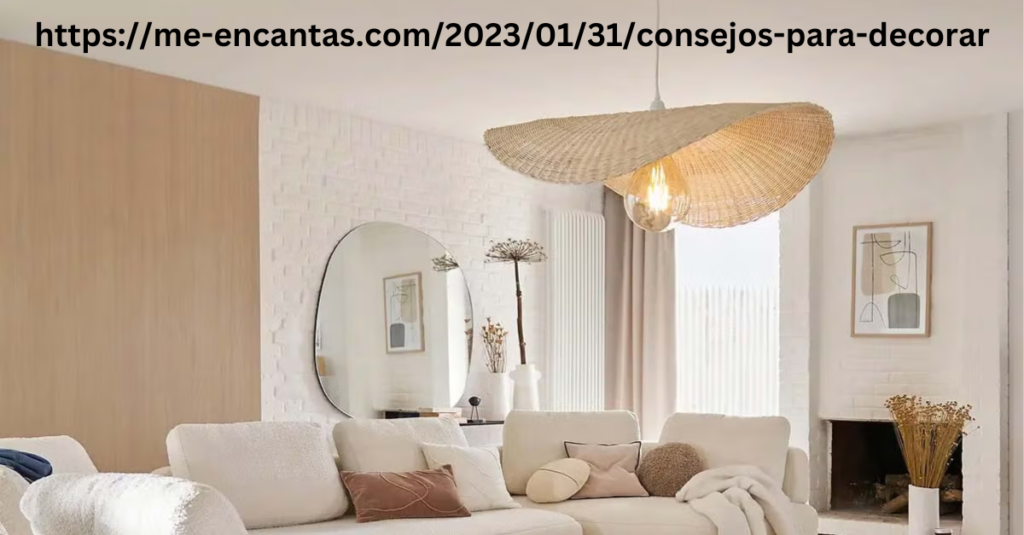Decorating your home or personal space is more than just a task—it’s an opportunity to express your personality, creativity, and preferences in a meaningful way. Whether you’re sprucing up a new apartment or refreshing a space you’ve lived in for years, the right design can make a space feel vibrant, comfortable, and uniquely yours. One of the best resources available for home decor enthusiasts is the article from https://me-encantas.com/2023/01/31/consejos-para-decorar, offering excellent advice on transforming spaces into welcoming and stylish havens.
In this comprehensive guide, we’ll explore some key principles and tips for decorating your home, based on the expert advice from the mentioned article. We’ll delve into colors, layouts, textures, and finishing touches that can elevate your space while staying true to your taste and needs.
1. Understanding the Basics of Home Decor
Before diving into the world of home decor, it’s essential to understand a few foundational concepts. These include understanding your space, identifying your style, and setting a budget.
Assess Your Space
Every room is different. Some may be large and open, while others are small and cozy. It’s important to assess your space’s size, shape, and natural lighting. These factors will influence how you decorate—large, open spaces may benefit from bold color schemes, while smaller rooms often look best with lighter shades that enhance the feeling of space.
Identify Your Style
Decorating your home can feel overwhelming if you don’t have a clear idea of your style. Do you prefer a modern, minimalist look? Or do you gravitate towards a more rustic, bohemian aesthetic? Take inspiration from different design sources, such as Pinterest, Instagram, and, of course, the expert advice found on https://me-encantas.com/2023/01/31/consejos-para-decorar.
Set a Budget
Decorating can quickly become expensive if you don’t set a budget. Start by determining how much you’re willing to spend on the entire project and allocate funds for different elements such as furniture, paint, and accessories. Don’t worry if your budget is small; there are plenty of affordable ways to make a space look stylish and cozy without breaking the bank.
2. Color Schemes: Bringing Harmony to Your Home
One of the most important aspects of any decor project is the color scheme. Colors can affect the mood of a room, influence how large or small the space feels, and create a sense of harmony.
Neutral Tones
Neutral tones such as beige, gray, and white are timeless and versatile. According to https://me-encantas.com/2023/01/31/consejos-para-decorar, using neutral tones as a base color allows you to layer more vibrant or bold shades through furniture, accessories, and artwork.
Bold Colors
If you love vibrant spaces, don’t be afraid to incorporate bold colors. Rich jewel tones like emerald green, deep blue, or burgundy can create a striking atmosphere. However, balance is key. Bold colors often work best when used sparingly or in specific areas, like accent walls or pieces of furniture, to prevent the room from feeling overwhelming.
Monochromatic Palettes
Monochromatic color schemes are based on variations of a single color. This creates a cohesive, harmonious look. For example, using varying shades of blue—such as sky blue, navy, and teal—can give a room a peaceful, oceanic feel while keeping the design unified.
3. Furniture and Layout: Creating Flow and Functionality
The furniture you choose plays a central role in both the functionality and aesthetics of a room. Selecting the right pieces and arranging them correctly can completely transform a space.
Choose Furniture Based on Function
Think about how the room will be used before purchasing furniture. A living room used primarily for relaxing may benefit from a comfortable sofa, armchairs, and a coffee table. A home office, on the other hand, would require a functional desk, a supportive chair, and ample storage. According to the suggestions from https://me-encantas.com/2023/01/31/consejos-para-decorar, furniture should be both aesthetically pleasing and practical.
Creating Balance
Balance is essential in interior design. One way to create balance is by using symmetrical furniture arrangements, such as placing two matching chairs on either side of a sofa. Alternatively, you can achieve a more dynamic balance through asymmetry by mixing different types of furniture in a complementary way.
Optimize Layout for Space
The layout of your furniture should maximize the available space and create a natural flow. For example, in a small room, choose furniture that’s appropriately scaled so the space doesn’t feel cramped. In a larger room, grouping furniture into zones—such as a seating area and a reading nook—can make the room feel cozier.
4. Lighting: Illuminating Your Space
Lighting plays a crucial role in creating the ambiance of a room. It can enhance the mood, highlight specific areas, and make the space feel more welcoming.
Layered Lighting
According to https://me-encantas.com/2023/01/31/consejos-para-decorar, a well-lit room should have layered lighting. This means incorporating multiple light sources at different levels. For example, use overhead lighting for general illumination, table lamps for task lighting, and floor lamps or wall sconces for accent lighting.
Natural Light
Take advantage of natural light by keeping windows unobstructed or using sheer curtains. Natural light makes a room feel airy and bright, and it can have a positive impact on your mood. Mirrors can also be used strategically to reflect and amplify natural light throughout the space.
Statement Lighting
Statement lighting fixtures—such as chandeliers, pendant lights, or artistic lamps—can act as focal points in a room. They not only provide light but also add an element of style and personality to the space.
5. Textures and Patterns: Adding Depth and Interest
Textures and patterns can take your decor to the next level by adding depth, contrast, and visual interest. Even if you stick to a neutral or monochromatic color scheme, mixing different textures and patterns can prevent the space from feeling flat or boring.
Mixing Textures
Don’t be afraid to mix textures. For example, pairing a soft, plush sofa with a sleek glass coffee table or rough-hewn wooden shelves can create a visually engaging contrast. Similarly, mixing fabrics like velvet, cotton, and linen adds richness and dimension to a room.
Incorporating Patterns
Patterns can be incorporated through textiles like rugs, curtains, and pillows, as well as through wallpaper or accent pieces. If you’re unsure about mixing patterns, start small with subtle patterns like stripes or polka dots, and gradually introduce bolder prints like florals or geometric designs.
6. Personal Touches: Making Your Space Unique
Finally, personalize your space with meaningful items and decorative pieces that reflect your personality. Incorporating unique elements such as artwork, photographs, travel souvenirs, or vintage finds can give your home character and make it feel uniquely yours.
Artwork and Wall Decor
Art is one of the easiest ways to add personality to a room. Whether it’s a large statement piece or a gallery wall of smaller prints, artwork can anchor the decor and create a focal point. The tips from https://me-encantas.com/2023/01/31/consejos-para-decorar suggest selecting artwork that resonates with you on a personal level, whether it’s an abstract painting, a nature photograph, or a family portrait.
Plants and Greenery
Incorporating plants into your decor not only adds a pop of color but also creates a calming, natural atmosphere. Choose plants that suit the lighting conditions of your space and consider adding a mix of different plant sizes and types for variety.
Conclusion
Decorating is an art form that combines creativity, practicality, and personal expression. Whether you’re revamping a single room or reimagining your entire home, the advice found on https://me-encantas.com/2023/01/31/consejos-para-decorar will guide you through the process with expert tips on everything from color selection to furniture layout. By understanding the basics of home decor, choosing the right colors, optimizing your layout, layering lighting, incorporating textures, and adding personal touches, you can transform any space into a beautiful, functional, and inviting haven.



